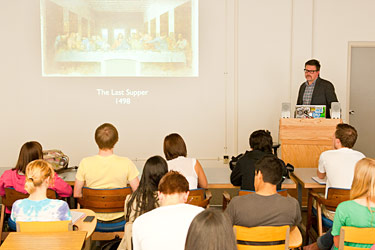Learn More About PUC
Students Participate in Innovative Art Education
By Katelynn Christensen and Larry Peña on April 7, 2011
Share this

College students have long felt the burden of textbooks—their weight, price tag, and time consumption. Since last spring, Pacific Union College art history professor Alexander Carpenter has simplified the lives of his students by integrating Smarthistory.org, a non-profit, multimedia art history “web-book,” into his lesson plans. This web resource combines the text and images of traditional textbooks with new features, like discussion video clips, to dynamically and engagingly supplement—or even replace—art survey course textbooks.
Now PUC students have gotten involved with the project directly, making their own impact on this increasingly popular web resource.
Smarthistory.org and the classroom meet as Carpenter requires students to watch the site’s discussion video clips and respond to a number of questions in preparation for upcoming lectures. “I’ve noticed that students seem to come to class better prepared,” he says. “[And] I think the questions are more engaging than what I had [students answering] before.”
Carpenter enjoys the flexibility offered by the website because he does not believe students retain information from long reading assignments as well as they could from multimedia sources. “As a student, I really didn’t like when teachers would assign a lot of [reading] because I felt like I didn’t know where to begin. I didn’t know where to end. I didn’t know what was going to be emphasized,” explains Carpenter. “So, I have dedicated myself to trying not to do that … I prefer very focused, small assignments. That’s what I like about this.”
Carpenter reports that students consistently respond positively to the web-book. “They are excited not to spend 80 bucks,” he shares. “I still give them some things to read, but [on the website] they get to listen to two fun, chatty people who are well educated, talking about art and art history.” Carpenter finds that a primary benefit of this process is that students are able to hear individuals other than their professor use the terms, names, grammar, and language of art as they critique and appreciate it.
The students have responded so well, in fact, that the people behind Smarthistory.org have taken notice. Last quarter a representative of the website contacted Carpenter to inform him that PUC is the website’s biggest user, and asked if PUC students would help the website pilot a new project. PUC is now the first college to have students record and upload videos of their own to Smarthistory.org’s YouTube page. On this supplementary site, students in Carpenter’s History of American Art classes discuss works by American artists and designers like Georgia O’Keefe, Frank Gehry, George Inness, and Andy Warhol.
“After using the website for classes and watching their videos, it was cool to be one of those people, discussing a work of art that I had chosen and was excited about,” says design/fine arts major Amador Jaojoco, who recorded a video discussing a piece by Southern California artist Greg Miller. “It was really fun to act as a mentor and apply what I had learned about art.”
Watch the videos by PUC students at www.youtube.com/smarthistorystudents.
Latest News
Young Observatory Reopens and Obtains New Technology
By Ally Romanes on January 8, 2026
Maxwell Scholar Feature: Liah Ronneburg
By Marina Maher on December 30, 2025
First Set of PUC’s North Coast Nursing Students Graduate
By Ally Romanes on December 23, 2025
Two Tonge Grants Awarded to M.A. in Communication and Aviation Program
By Marina Maher on December 22, 2025
